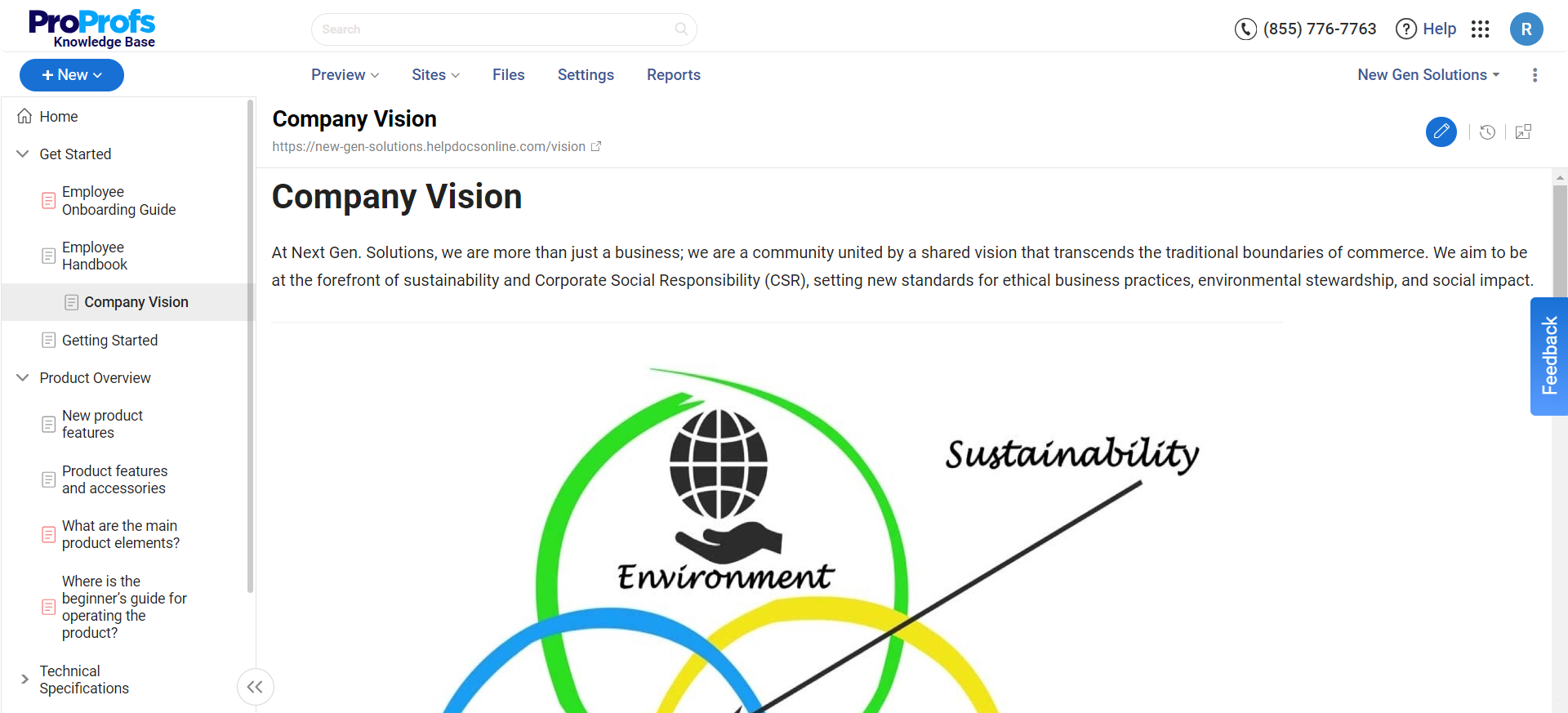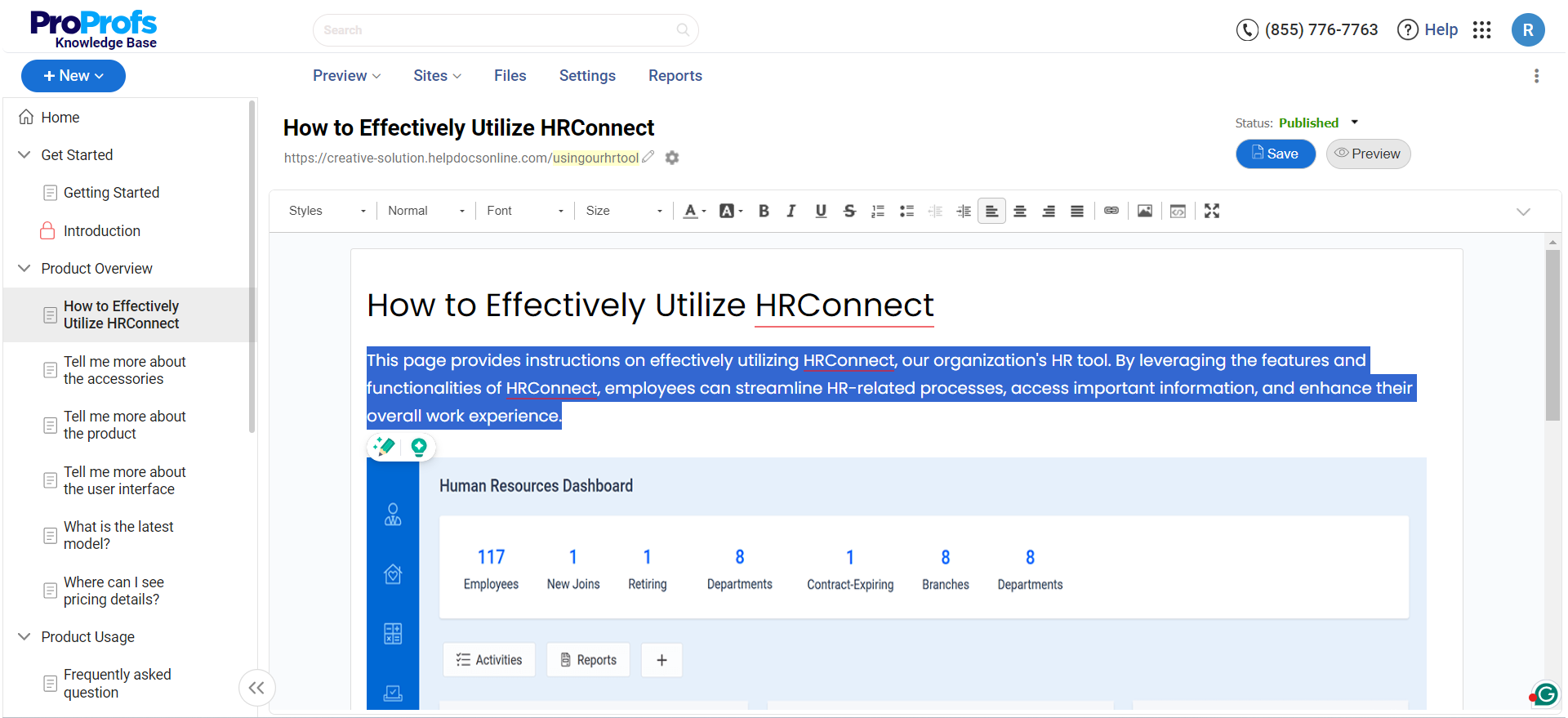
ProProfs Knowledge Base Editorial Team is a diverse group of professionals passionate about knowledge management. We update you on the latest trends, dive into technical topics, and offer insights to elevate your business.
Learn about Our Editorial Process Updated: 6 Aug, 2024
Training documentation is indispensable for any organization looking to enhance the effectiveness of its training programs.
These documents streamline the learning experience and ensure consistency and quality across training sessions by meticulously outlining the training process, objectives, and resources.
According to a LinkedIn report, around 93% of employees will stay longer in a company, provided the due focus is given to their career progression and skill enhancement.
In this blog, we will discuss the importance and types of training documentation. We will also learn how to create effective training documentation and how training documentation software can help.

According to a report by McKinsey, employees spend 19% of their work time searching for information. If tasks like gathering information and collaborating with colleagues consume most of an employee’s day, it’s likely to dwindle his or her productivity.
This problem can easily be solved with the help of online training documentation. When critical information related to work processes, policies, clients, products, etc., is documented on a centralized platform, it gets easy for employees to get what they need in a jiffy.
They don’t have to approach multiple people to receive information or send emails and wait for a response. Employees can refer to the documentation to access data instantly while they are working on a project, making a presentation, creating a pitch, or doing anything specific to their roles.

These comprehensive guides communicate a company’s mission, values, policies, and procedures to its staff. These are crucial for onboarding new employees, as they convey what is expected from them regarding behavior, responsibilities, and workplace norms.
Employee handbooks usually include information on company culture, benefits, disciplinary procedures, and safety protocols. They serve as a reference guide for employees throughout their tenure at the company, ensuring consistent understanding and adherence to company policies.

These are comprehensive manuals aimed at helping users understand how to operate a product or software. These are usually written in simple language and include step-by-step instructions complemented by visuals like diagrams or screenshots.
User guides are crucial for training users on complex equipment or software to ensure maximum product usability and self-service. Well-crafted, extensive user guides improve customer satisfaction and reduce the burden on support teams by empowering users to solve issues independently.

These are part of an online library that provides self-service support for users or employees. These articles cover topics like frequently asked questions (FAQs), troubleshooting guides, how-to articles, and problem-solving instructions.
Knowledge bases allow users to find information quickly without waiting for assistance and are continually updated to reflect new insights and solutions. They are crucial for ongoing learning and support, enhancing user autonomy and efficiency.
This consists of specific guides for individual tasks within a company and provides detailed, step-by-step instructions on performing a particular task effectively and efficiently.
It is crucial for training new or cross-training existing employees in new roles. It helps ensure that tasks are completed consistently and correctly across all shifts and personnel changes, helping maintain operational reliability and quality.
It refers to the content resources generated during project execution. It could include project plans, schedules, status reports, and final project deliverables.
It helps keep all stakeholders informed and engaged, facilitates project management, and serves as a historical record for future reference. It enables teams to stay aligned with project goals and requirements and provides a framework for evaluating project performance against established metrics.

SOPs are comprehensive, written instructions to achieve uniformity in performing a specific function. SOPs are critical in environments that require strict adherence to specific standards to maintain quality and compliance, such as manufacturing, pharmaceuticals, and any regulatory environment.
Good SOPs reduce learning curves and mistakes by providing clear, actionable information on performing complex tasks effectively. They are essential for training new employees and ensuring consistent execution by all staff.
Creating adequate training documentation requires a strategic process to enhance learning and operational efficiency within an organization.
Let’s discuss all the essential steps involved in training documentation.
Start by defining the purpose of the documentation by asking yourself:
Understanding the purpose will guide the content and structure of your documentation. The next step is identifying the target audience by analyzing their existing knowledge, learning needs, and how they will use the documentation.
Gather all necessary information that needs to be included in the documentation. Consult with subject matter experts (SMEs) to ensure accuracy and comprehensiveness.
Put together existing resources, like manuals, procedural documents, and training materials that can be repurposed or updated. This step is crucial to ensure all relevant and correct information is covered in the documentation.
Choose the most suitable format based on the content, purpose, and audience. Such options could include written documents like PDFs, interactive e-learning modules, video tutorials, or a combination.
The format should enable easy learning and access, suitable for different learning styles and preferences.

Start with an outline to organize the topics in a logical manner. Use clear, concise language appropriate for the target audience.
Add visual elements like diagrams, infographics, and videos to enhance understanding and engagement. Cover all the essential topics, such as step-by-step procedures, tips, best practices, and common troubleshooting issues.

Before finalizing the documentation content, have it reviewed by SMEs and potential users to ensure accuracy and usability.
Feedback is crucial to ensure the documentation meets learning objectives and is user-friendly. Although this process could involve several revisions based on feedback, it provides credibility and subject-matter expertise.
Once the content is edited and approved, finalize the formatting and layout. If the documentation is digital, ensure it is compatible with all intended platforms and devices.
Share the documentation with users through the appropriate channels, like learning management systems (LMS), company intranets, or direct email.
Once the documentation is live, regularly monitor its effectiveness through user feedback and performance assessments. Evaluate if the training goals are being met and identify areas for improvement.
This should be part of the lifecycle of your documentation to accommodate changes in processes, technology, and regulatory requirements.

CDS Convert employs a clear and user-friendly approach with its instructional content. It uses simple language and logical sequencing of steps, supported by screenshots, to guide users effectively.
The minimalistic design emphasizes readability with bold highlights for key points and a layout optimized for easy navigation. Additional resources are accessible via a well-organized sidebar, enhancing the learning experience by facilitating access to related topics.

Apple showcases its characteristic clear and engaging writing style with high usability in mind, using direct, concise language that makes technical information accessible to users of all skill levels.
The guide is visually rich, with crisp images and icons corresponding to the instructions, enhancing comprehension and retention.
The layout is intuitively organized, with well-defined sections and a navigable interface encouraging exploration and ease of use. This design ethos ensures that users can efficiently find and apply the necessary information.

NFIB’s employee handbook takes a structured and systematic approach to communication. It starts with a welcome message, an effective strategy to set a positive tone and engage employees from the outset.
Following this introduction, the key sections include company history, missions, values, and a comprehensive breakdown of employment policies, procedures, and benefits.
The handbook maintains a professional yet approachable tone throughout, which helps in making the information feel more accessible to employees. The language is clear and concise, aiming to eliminate any ambiguity about company policies.
Training documentation ensures that employees are well-equipped with the knowledge and skills required to perform their roles efficiently.
Well-crafted training documentation helps reduce onboarding times and ensures consistency in training to comply with industry standards and enhance employee engagement.
ProProfs Knowledge Base can streamline the creation and management of training documentation. Its user-friendly interface allows you to easily create comprehensive training manuals, step-by-step guides, and interactive FAQs.
It lets users incorporate multimedia elements, like images, videos, and diagrams, to make training materials more engagin. Its robust collaboration features like smart user management, conditional content, internal comments, and more, your team can collaborate easily. Explore the tool more and get started.
FREE. All Features. FOREVER!
Try our Forever FREE account with all premium features!